Nasi goreng
Nasi goreng (English pronunciation: /ˌnɑːsi ɡɒˈrɛŋ/), literally meaning "fried rice" in both the Indonesian and Malay languages,[4][5] is an Indonesian rice dish with pieces of meat and vegetables added.[6] It can refer simply to fried pre-cooked rice, a meal including stir fried rice in a small amount of cooking oil or margarine, typically spiced with kecap manis (sweet soy sauce), shallot, garlic, ground shrimp paste, tamarind and chilli and accompanied by other ingredients, particularly egg, chicken and prawns. There is also another kind of nasi goreng which is made with ikan asin (salted dried fish) which is also popular across Indonesia. Nasi goreng is sometimes described as Indonesian stir-fried rice,[1][2] although it is also popular in Southeast Asia. Beyond the Malay Archipelago, it has gained popularity through Indonesian influence in Sri Lanka[7] and via Indonesian immigrant communities in Suriname[8] and the Netherlands.[9] It is distinguished from other Asian fried rice recipes by its aromatic, earthy and smoky flavor, owed to generous amount of caramelised sweet soy sauce and powdered shrimp paste, and the taste is stronger and spicier compared to Chinese fried rice.[10]
 Indonesian nasi goreng – fried rice with egg, krupuk (traditional cracker) and pickles. | |
| Course | Main course |
|---|---|
| Place of origin | Indonesia[1][2] |
| Region or state | Nationwide in Indonesia, Malaysia, Singapore and Brunei; also popular in Southern Thailand, Sri Lanka, Suriname and the Netherlands |
| Associated national cuisine | Indonesia,[3] Malaysia, Brunei and Singapore |
| Main ingredients | Fried rice with meats, vegetables and spices, usually seasoned with sweet soy sauce |
| Variations | Rich variations across the respective region |
Nasi goreng has been called the national dish of Indonesia,[3][11][12] though there are many other contenders. It can be enjoyed in simple versions from a tin plate at a roadside food stall, eaten on porcelain in restaurants, or collected from the buffet tables of Jakarta dinner parties.[13]
In 2011 an online poll by 35,000 people held by CNN International chose Indonesian nasi goreng as number two on their 'World's 50 Most Delicious Foods' list after rendang.[14]
History

Nasi goreng had the same beginnings as other versions of fried rice; as a way to avoid wasting rice.[15] Frying the rice could prevent the propagation of dangerous microbes, especially in pre-refrigeration technology Indonesia and also avoid the need to throw out precious food.[16] Nasi goreng is traditionally served at home for breakfast and it is traditionally made out of leftover rice from the night before. Besides ingredients like shallot, tomato, pepper and chili, the rice is fried with scraps of chicken or beef; usually leftovers from a chicken or beef dish.[17]
Nasi goreng is often described as Indonesia's twist on fried rice.[16] And as with other fried rice recipes in Asia, it has been suggested that it can trace its origin from Southern Chinese fried rice.[18][19] However, it is not clear when Indonesians began to adopt the Chinese fried rice and create their own version. The trade between China and the Indonesian archipelago flourished from the era of Srivijaya around the 10th century and intensified in the Majapahit era around the 15th century. By that time Chinese immigrants had begun to settle in the archipelago, bringing along with them their culture and cuisine. Chinese people usually favour freshly cooked hot food, and in their culture it is taboo to throw away uneaten foodstuffs.[15] As a result, the previous day's leftover rice was often recooked in the morning. Previously, Indonesians probably simply sun-dried the leftover rice to make intip or rengginang (rice cracker), the dried rice also could be ground to make rice flour.
The Chinese influences upon Indonesian cuisine can be seen in mie goreng that appeared simultaneously with the introduction of the stir frying technique that required the use of a Chinese wok.[20] In China, the stir frying technique became increasingly popular during Ming dynasty (1368–1644 CE).[21] The introduction of stir frying technique, Chinese wok, and also soy sauce probably took place around or after this period, circa 15th to 17th century. The common soy sauce has its origin in 2nd century CE China, however, kecap manis (sweet soy sauce) was developed in Indonesia with a generous addition of local palm sugar.[22] Sweet soy sauce plus the addition of shrimp paste are the elements that distinguish Indonesian nasi goreng from Chinese fried rice.
Other than Chinese influence, there is another theory suggested that nasi goreng was actually inspired by a Middle Eastern dish called pilaf, which is rice cooked in seasoned broth.[23] This suggestion is quite plausible in regard to a particular variant—the Betawi nasi goreng kambing (Jakartan goat fried rice), which uses mutton or goat meat (traditionally favoured by Arab Indonesians), rich spices and minyak samin (ghee), which demonstrates Middle Eastern-Indian influence.
Nasi goreng was considered as part of the Indies culture during the colonial period. The mention of nasi goreng appear in colonial literature of Dutch East Indies, such as in the Student Hidjo by Marco Kartodikoromo, a serial story published in Sinar Hindia newspaper in 1918.[15] It was mentioned in a 1925 Dutch cookbook Groot Nieuw Volledig Oost Indisch Kookboek.[24] Trade between the Netherlands and the Dutch East Indies during that time has increased the popularity of nasi goreng to the world.[25]
After the independence of Indonesia, nasi goreng was popularly considered as a national dish, albeit unofficial.[15][26] Its simplicity and versatility has contributed to its popularity and made it as a staple among Indonesian households—colloquially considered as the most "democratic" dish since the absence of an exact and rigid recipe has allowed people to do anything they want with it.[27] Nasi goreng that is commonly consumed daily in Indonesian households was considered as the quintessential dish that represent an Indonesian family. It is in the menu, introduced, offered and served in Indonesian Theater Restaurant within the Indonesian pavilion at the 1964 New York World's Fair. Howard Palfrey Jones, the US ambassador to Indonesia during the last years of Sukarno's reign in mid 1960s, in his memoir "Indonesia: The Possible Dream", said that he like nasi goreng. He described his fondness for nasi goreng cooked by Hartini, one of Sukarno's wives, and praise it as the most delicious nasi goreng he ever tasted.[15]
Nasi goreng is ubiquitous in Indonesia, and also popular in neighbouring Malaysia and Singapore, as well as the Netherlands through its colonial ties with Indonesia.[9] Today microwave-heated frozen nasi goreng is available in convenience stores, such as 7-Eleven and Lawson in Indonesia.
Ingredients

Nasi goreng is distinguished from other Asian fried rice recipes by its aromatic, earthy and smoky flavour,[28] owed to generous amount of caramelised kecap manis (sweet soy sauce) and ground powdered terasi (shrimp paste), and the flavour is stronger and spicier compared to Chinese fried rice.[10] Nasi goreng often includes krupuk and bawang goreng (fried shallots) or (fried onions) to give a crispier texture.
The main ingredients of nasi goreng include pre-cooked rice, sweet soy sauce, powdered terasi (shrimp paste), salt, garlic, shallot, chilli pepper, spring onions, nutmeg, turmeric, vegetable oil, onions, palm sugar, ginger garlic paste, and slices of cucumber and tomato for garnishing. Some recipes may add black pepper, fish sauce, or powdered broth as a seasoning and taste enhancer. Eggs might be mixed into fried rice or fried separately, either as telur ceplok/telur mata sapi (sunny side up eggs), or telur dadar (omelette), and also telur rebus (boiled eggs). Originally optional, the addition of fried egg is often named as nasi goreng spesial (pakai telur) or special fried rice topped with fried egg.
Condiments
Nasi goreng often add condiments as add-on upon the fried rice. Fried shallot and traditional crackers are often sprinkled upon to give crispy texture, pickles are added to give sour freshness in otherwise rather oily dish, a fried egg is often placed on top of the dish to add savouriness, while chili paste is to add the zesty spiciness according to one's preference. Some common condiments are:
- Bawang goreng: fried shallot, sprinkled upon nasi goreng
- Kerupuk: various types of crackers, usually emping or prawn crackers
- Acar: pickles made from vinegar preserved cucumber, shallots, carrot, and small chilli pepper
- Telur: egg; could be cooked in many ways and placed on the nasi goreng, usually fried or omelette
- Sambal: chilli sauce
Variations
There is no single recipe of nasi goreng, as every fried rice dish with certain mixtures, additions, ingredients, and toppings could lead to another recipe of nasi goreng.[29] Usually, in Indonesian households, the ingredients of nasi goreng prepared for daily breakfast are the leftovers of the previous day's meals preserved in the refrigerator, with fresh vegetables and eggs added. The basic ingredients of nasi goreng are rice and sliced or ground bumbu (spices) mixture of shallot, garlic, pepper, salt, tomato ketchup, sambal or chili sauce, and usually sweet soy sauce. Some variants may add saus tiram (oyster sauce), ang-ciu (Chinese cooking red wine), kecap ikan (fish sauce), or kecap inggris (like Worcestershire sauce). The texture of leftover cooked rice is considered more suitable for nasi goreng than that of newly cooked rice, as freshly cooked rice is too moist and soft.
Nasi goreng is known as fried rice variants commonly found in Indonesia, Malaysia, Singapore and Brunei. Despite myriad specific regional variants, it is notable that certain recipe appears in multiple countries, kampung (village), shrimp paste, sambal, salted fish and egg-wrapped fried rices are appears in both Indonesia and Malaysia. There are similar fried rice dishes from neighbouring countries, such as khao phat from Thailand, and sinangag from the Philippines.
Indonesia
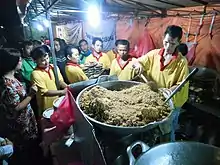
 |
| This article is part of the series on |
| Indonesian cuisine Masakan Indonesia |
|---|
|
|
In most parts of Indonesia, nasi goreng is cooked with ample amounts of kecap manis (sweet soy sauce) that creates a golden brownish colour, and the flavour is mildly sweet.[1] However, in other places such as Eastern Indonesia (Sulawesi and Maluku), the sweet soy sauce is usually absent and is replaced by bottled tomato and chili sauce, creating reddish-coloured nasi goreng. This variant is called nasi goreng merah (red fried rice) or nasi goreng Makassar after the South Sulawesi capital. Some variants of nasi goreng, such as salted fish or teri Medan (Medan's anchovy) nasi goreng, do not use kecap manis at all, creating a lighter colour similar to Chinese fried rice or Japanese chahan.
Nasi goreng Kambing Kebon Sirih is a popular variant of goat meat fried rice sold in the Kebon Sirih area, Central Jakarta;[30] while nasi goreng amplop is fried rice "enveloped" inside thin omelette skin, almost identical to Malaysian nasi goreng pattaya.
The most common nasi goreng variants usually use chicken and egg, however, some variants are named after their additional ingredients. Specific examples of nasi goreng include:
- Nasi goreng ayam (with chicken)[31]
- Nasi goreng kambing (with goat meat)[32]
- Nasi goreng domba (with mutton)[33]
- Nasi goreng sapi (with beef)[34]
- Nasi goreng babi (with pork, usually served with Chinese pork belly and charsiu)[35]
- Nasi goreng babat gongso (with tripe), a tripe fried rice from Semarang[36]
- Nasi goreng dendeng lemak (with fatty dendeng thin beef jerky) also known as nasi goreng tiarbah[37]
- Nasi goreng usus (with intestine)[38]
- Nasi goreng ati ampela (with chicken liver and gizzard)[39]
- Nasi goreng pete/petai (with green stinky bean)[40]
- Nasi goreng jengkol (with jengkol stinky pea)[41]
- Nasi goreng telur (with egg)[42]
- Nasi goreng telur asin (with salted duck egg)[43]
- Nasi goreng udang (with shrimp)[44]
- Nasi goreng cakalang (with skipjack tuna), speciality of Manado[45]
- Nasi goreng roa (with halfbeak fish), also speciality of Manado[46]
- Nasi goreng tuna (with tuna)[47]
- Nasi goreng cumi (with squid)[48]
- Nasi goreng seafood (with seafood, such as squid, fish and shrimp)[32]
- Nasi goreng ikan asin (with salted fish)[32]
- Nasi goreng teri Medan (with Medan's anchovy)[49]
- Nasi goreng ebi (with salted dried shrimp)[50]
- Nasi goreng jamur (with mushroom)[51]
- Nasi goreng sosis (with beef or chicken sausages)[52]
- Nasi goreng kornet (with corned beef and margarine)[53]
- Nasi goreng daging asap (with smoked beef)[54]
- Nasi goreng siram (fried rice poured with chicken and vegetables soup/sauce)[55]
- Nasi goreng tomat (tomato fried rice)[56]
- Nasi goreng bayam (spinach fried rice)[57]
- Nasi goreng lada hitam (black pepper fried rice)[58]
- Nasi goreng saus tiram (oyster sauce fried rice)[59]
- Nasi goreng saus teriyaki (teriyaki sauce fried rice) usually beef or chicken fried rice in teriyaki sauce, a Japanese influence in Indonesia[60]
- Nasi goreng keju (with cheese, either mozzarella or cheddar)[61]
- Nasi goreng rendang (rendang fried rice), rich and spicy fried rice usually made from leftover rendang spices[62]
- Nasi goreng spesial (special fried rice) with complete ingredients, including chicken, egg mixed in rice, sausages, vegetables, and topped with sunny side up fried egg[32]
- Nasi goreng Jawa (Javanese fried rice)[63]
- Nasi goreng Sunda (Sundanese fried rice), spicy fried rice with ample of kunyit (turmeric) which add golden yellow colour[32]
- Nasi goreng Bali (Balinese fried rice), rich in spices including chopped lemongrass, turmeric, shallot, garlic and galangal, and uses no soy sauce.[64]
- Nasi goreng Aceh (Acehnese fried rice), rich in spices akin to mie aceh[65]
- Nasi goreng Padang (Padang fried rice), also rich in spices similar to Aceh fried rice[66]
- Nasi goreng Magelangan (Magelang fried rice) or also called as Nasi goreng Mawut (scrambled or mixed up fried rice),[32] a combo of fried rice and noodle with vegetables and spices[67]
- Nasi goreng krengsengan (with meat and fresh cabbage), spicy fried rice with chopped noodles and meat, similar to nasi goreng Magelangan[68]
- Nasi goreng rempah, spicy fried rice with ample of bumbu spice mixture[69]
- Nasi goreng petis (with petis), a thick black paste made of shrimp paste or fish paste, specialty of East Java[70]
- Nasi goreng sambal terasi (Sambal shrimp paste fried rice), or simply nasi goreng terasi (terasi shrimp paste fried rice)[71]
- Nasi goreng sambal ijo/hijau (green sambal fried rice),[72] often simply called nasi goreng hijau (green fried rice)[73]
- Nasi goreng pedas, hot and spicy fried rice with chili peppers[74]
- Nasi goreng rawit, extra hot and spicy fried rice with cabe rawit or bird's eye chili[75]
- Nasi goreng jancuk, extra hot and spicy fried rice from Surabaya[32]
- Nasi goreng setan (devil's fried rice), extra hot and spicy fried rice with various types of chili peppers, including sambal paste, sliced fresh bird's-eye chili and chili powder[76][77]
- Nasi goreng merah or nasi goreng Makassar (red fried rice)[78]
- Nasi goreng hitam (black fried rice), or nasi goreng cumi hitam, coloured and flavoured with squid ink[79]
- Nasi goreng pelangi (rainbow fried rice), without soy sauce with colourful vegetables[80]
- Nasi goreng amplop (egg-enveloped fried rice), also known as nasi goreng pattaya[81]
- Nasi goreng santri (vegetarian fried rice)[82]
- Nasi goreng nanas (pineapple fried rice), also known as nasi goreng Hawaii or nasi goreng Thailand[83]
- Nasi goreng gila (crazy fried rice), fried rice topped with more savoury additional ingredients including chicken, meat, shrimp, sliced bakso, sausages, egg, etc.[84]
Indonesians also called foreign versions of fried rice simply as nasi goreng, thus nasi goreng Hongkong and nasi goreng Tionghoa/China refer to Chinese fried rice, while nasi goreng Jepang refer to yakimeshi or chahan.[85]
Malaysia
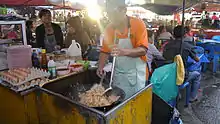
Nasi goreng is a commonly popular household dish in Malaysia.[86] It is also can be found in restaurants and food courts in the country.
Nasi goreng variants popular in Malaysia includes:
- Nasi goreng ayam (fried rice usually served with crispy fried chicken with sweet chilli sauce)
- Nasi goreng belacan (fried with leftover sambal belacan and fish or other meats)
- Nasi goreng blackpepper (fried rice with chicken or beef in blackpepper sauce)
- Nasi goreng cendawan (fried rice cooked with mushrooms)
- Nasi goreng cili api/masak pedas (spicy fried rice served with chicken/beef)
- Nasi goreng dabai (a Sarawak speciality which the rice is fried with a seasonal native fruit called 'buah dabai').
- Nasi goreng daging/kambing (fried rice with beef or mutton)
- Nasi goreng ikan masin (fried with salted fish)
- Nasi goreng kampung (fried with anchovies/leftover fried fish, kangkong)
- Nasi goreng kerabu (fried rice with local salads)
- Nasi goreng kunyit (fried rice served with turmeric and meat with onions, long beans and carrots)
- Nasi goreng kari (fried rice cooked with curry)
- Nasi goreng ladna (fried rice cooked with seafood and vegetables in white gravy)
- Nasi goreng masak merah (fried rice with chicken or beef in chilli gravy)
- Nasi goreng mamak (Indian Muslim style nasi goreng)
- Nasi goreng nenas (fried rice cooked with pineapples)
- Nasi goreng paprik (fried rice served with paprik dish, usually chicken)
- Nasi goreng pattaya (fried rice in an omelette envelope, sometimes includes chicken)[87]
- Nasi goreng petai (fried rice cooked with parkia speciosa)
- Nasi goreng seafood (fried with prawn, calamari slices and crab sticks)
- Nasi goreng sotong (fried rice cooked with calamary)
- Nasi goreng telur (fried rice served with fried eggs)
- Nasi goreng tomyam (fried rice cooked in tomyum paste)
- Nasi goreng udang (fried rice cooked with prawn)
- Nasi goreng USA (fried rice with three luxury ingredients namely prawn (udang), squid (sotong) and chicken (ayam))
- Nasi goreng Amerika (with fried egg and stirred fried beef in chili sauce)
Singapore
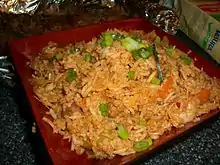
In Singapore, nasi goreng is one of the most popular rice dishes and is a staple with a lot of variations of it. Some include sausage, stinky beans (for vegetarians), seafood, and beef—chicken however, is the most common meat. Nasi goreng variants commonly popular in Singapore includes:
- Nasi goreng Singapore or Singapore-style fried rice (A unique combination of Chinese seasonings and Indian spices are used to flavor this simple fried rice dish made with shrimp, mushrooms, cabbage and carrots )
- Nasi goreng ayam or Chichen fried rice (fried rice with chicken)
- Nasi goreng telur Singapore or Singapore egg fried rice(simply fried with egg)
- Nasi goreng seafood (fried with mixed of squid, crab and shrimp)
- Nasi goreng pedas or Spicy Fried Rice (spicy fried rice)
- Nasi goreng sayur or Singapore vegetable fried rice (fried with vegetables)
- Nasi goreng sambal or Sambal fried rice (Malay fried rice with sambal or chili paste)
- Nasi goreng kampung or Village-Style Fried Rice (traditional Malay fried)
- Nasi goreng lapis or Layered fried rice (fried rice layered with lot of veggies, noodles and adorned with chicken on the top layer)
- Nasi goreng daging Mongolia or Mongolian Beef Fried Rice (fried rice mixed together with Mongolian beef style)
- Nasi goreng daging or Beef fried rice (fried with beef)
- Nasi goreng kari or Curry flavoured fried rice (fried rice flavoured with curry powder)
- Nasi goreng ayam ham or Chicken ham fried rice (fried with chicken ham)
Singapore has an ethnic Chinese majority that has influenced local cuisine. Chinese fried rice recipes, such as Yeung Chow fried rice also popular throughout in Singapore.
Brunei
Nasi goreng is a common rice dish in Brunei. Nasi goreng ikan masin or fried rice with salted fish is the most popular version.[88]
Nasi goreng variants commonly popular in Brunei includes:
- Nasi goreng pulau Brunei (floating fried rice)
- Nasi goreng belutak (fried rice with Brunei sausage, Belutak. Belutak is made up of salted minced meat stuffed into casings of cow's or buffalo's small intestines )
- Nasi goreng corned beef (fried with corned beef)
- Nasi goreng ikan masin (fried with salted fish)
- Nasi goreng kampung Brunei (fried with shrimp paste)
- Nasi goreng sardin (fried with sardine)
- Nasi goreng keropok belinjau (fried rice served with keropok belinjau)
- Nasi goreng seafood (fried with mixed of squid, crab and shrimp)
Sri Lanka
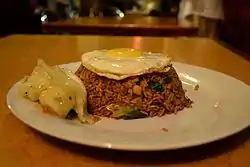
Nasi goreng (Sinhala: නාසි ගොරේන්) is a common dish in Sri Lanka. It was adopted into Sri Lankan cuisine through cultural influences from the Sri Lankan Malays and Indonesia.[89] It is prepared using a variety of ingredients including spices, soy sauce, oyster sauce, ginger, white onion, shrimp, cucumber and prawns.[89]
Netherlands
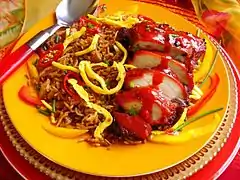
In the Netherlands, Indonesian cuisine is common due to the historical colonial ties with Indonesia. Indonesian migrants (or their offspring) cater Indonesian food both in restaurants and as take-away. Also, take-away versions of nasi goreng are plentiful in toko Asian grocery shop and supermarkets.[9] Supermarkets also commonly carry several brands of spice mix for nasi goreng, along with krupuk and other Indonesian cooking supplies. Chinese take-aways and restaurants have also adapted nasi goreng, plus a selection of other Indonesian dishes, but spice them Cantonese style. In Flanders, the name nasi goreng is often used for any Asian style of fried rice. Distinctive version of nasi goreng has been developed, such as Javanese-Suriname version of the dish.[8] In the Netherlands, nasi goreng has been developed into snack called nasischijf (Dutch for "nasi disk"), it is a Dutch deep-fried fast food, consisting of nasi goreng inside a crust of breadcrumbs.
Servings
Homemade
Nasi goreng can be eaten at any time of day, and many Indonesians, Malaysians and Singaporeans eat nasi goreng for breakfast.[18] In most of households, last night leftovers stored in refrigerator are often used to create nasi goreng for breakfast; such as chunks of chicken, shrimp, vegetables, fish, beef, bakso or sausages. The rice used to make nasi goreng is cooked ahead of time and left to cool down (so it is not soggy), which is one reason to use rice cooked from the day before.
Street vendor

While most Indonesian households serve it for breakfast, nasi goreng is also a popular choice for late night supper served by street vendors, in warungs and also by travelling night hawkers that frequent Indonesian residential neighbourhoods with their wheeled carts.[18] The nasi goreng is usually cooked on order for each serving, since the cook usually asks the client their preference on the degree of spiciness: mild, medium, hot or extra hot. The spiciness corresponds to the amount of sambal or chili pepper paste used. The cook might also ask how the client would like their egg done: mixed into nasi goreng or fried separately as telur mata sapi or ceplok (fried whole egg) or as telur dadar (omelette). The term spesial pakai telur means the nasi goreng has two eggs per serving, one mixed into the nasi goreng as scrambled egg, another fried separately. As well as offering nasi goreng, the travelling nasi goreng cart vendors usually also serve mi goreng, mi rebus, and kwetiau goreng. Nasi goreng usually made by order, nevertheless, some popular nasi goreng warung or food stall might cook them in bulk, due to large demand. The degree of spiciness is applied by customer through the addition of sambal hot sauces.
Restaurant

Nasi goreng is a popular dish in Indonesian restaurants and Asian fusion restaurants. It is often served for breakfast in Indonesian hotels. In Indonesian restaurants, the dish is often served as a main meal accompanied by additional items such as a fried egg, ayam goreng (fried chicken), satay, vegetables, seafoods such as fried shrimp or fish, and kerupuk (meaning crackers, also called "prawn crackers" and many other names).[90] Although traditionally nasi goreng is seldom consumed with satay nor fried chicken, in many Indonesian restaurants abroad this combo is quite popular—in order to allow clients to sample quintessential Indonesian dish; nasi goreng and satay in single serving.
In many warungs (street stalls), when accompanied by a fried egg, it is sometimes called nasi goreng istimewa (special fried rice).[91] Nasi goreng is usually sold together with bakmi goreng (fried noodles) and mie rebus (noodle soup). They sell a simple nasi goreng with small amount of shredded fried chicken, scrambled egg, green vegetables, and served with pickled cucumber. In Indonesia there are restaurant chains that specialise on serving nasi goreng.[92][93]
Convenience store
Some seasoning brands sold in supermarkets, such as Sajiku-Ajinomoto, Racik, LaRasa, Royco and Kokita offering "bumbu nasi goreng", an instant nasi goreng seasoning paste to be applied upon frying leftover rice.[94] Today the modern convenience stores such as 7-Eleven and Lawson operated in Indonesia also offering prepackage frozen microwave-heated nasi goreng take away.[95]
In popular culture
- Tante Lien's song "Geef Mij Maar Nasi Goreng" (Just Give Me Nasi Goreng), composed and recorded in 1979, illustrates historical culinary ties between the Netherlands and Indonesia, as well as whimsically describing the craving of people of Indo (Eurasian) descent repatriated in the Netherlands for Indonesian cuisine.[96]
- During their 2016 concert in Indonesia, the Australian band 5 Seconds of Summer dedicated a song inspired by the dish entitled "Nasi Goreng".[97]
- In February 1973 Philip Proctor and Peter Bergman from The Firesign Theatre released their first solo album TV or Not TV on which a character named "Nasi Goreng" sings a song of the same name to introduce himself.
- The titular police division in the Japanese comedy series Tokyo Metropolitan Police Department, Nasi Goreng Division (警視庁 ナシゴレン課, Keishichou Nasi Goreng-ka) is named after the dish.
Gallery
- Nasi goreng variants
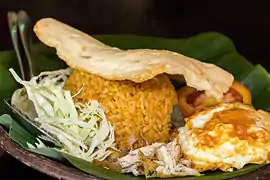 Nasi goreng with chicken, egg and prawn cracker
Nasi goreng with chicken, egg and prawn cracker Nasi goreng with shrimp and egg, typical Indonesian breakfast
Nasi goreng with shrimp and egg, typical Indonesian breakfast Nasi goreng with chicken and egg in Bali
Nasi goreng with chicken and egg in Bali Nasi goreng with salted fish and egg
Nasi goreng with salted fish and egg Red nasi goreng in Rantepao, South Sulawesi
Red nasi goreng in Rantepao, South Sulawesi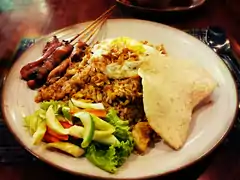 Nasi goreng-chicken satay combo, quintessential Indonesian dish among foreigners
Nasi goreng-chicken satay combo, quintessential Indonesian dish among foreigners Nasi goreng "Chinese style" in Jakarta
Nasi goreng "Chinese style" in Jakarta Nasi goreng "Hong Kong style" in Mataram, Lombok
Nasi goreng "Hong Kong style" in Mataram, Lombok Mushroom nasi goreng in Yogyakarta
Mushroom nasi goreng in Yogyakarta Vegetarian nasi goreng in Bali
Vegetarian nasi goreng in Bali Nasi goreng seafood in Sandakan, Sabah, East Malaysia
Nasi goreng seafood in Sandakan, Sabah, East Malaysia
See also
References
- Andrea Chesman (1998). 366 Delicious Ways to Cook Rice, Beans, and Grains. Penguin. ISBN 9781101075746.
- Stein, Rick. "Indonesian stir-fried rice (Nasi goreng)". BBC Food Recipes. Archived from the original on 19 August 2015. Retrieved 3 August 2015.
- Media, Kompas Cyber. "Kemenpar Tetapkan 5 Makanan Nasional Indonesia, Ini Daftarnya". KOMPAS.com (in Indonesian). Retrieved 18 April 2018.
- "nasi goreng | Indonesian to English Translation – Oxford Dictionaries". Oxford Indonesian Living Dictionary. Retrieved 23 July 2018.
- "Malay Dictionary Online Translation LEXILOGOS >>".
- "nasi goreng Meaning in the Cambridge English Dictionary". dictionary.cambridge.org. Retrieved 23 July 2018.
- Jayani Senanayake (1 January 2016). "Who doesn't like Nasi Goreng?". peckishme.com.
- "Indonesian rice dishes from the Surinam cuisine". tropilab.com.
- Ena Scheerstra (30 October 2012). "Dutch East Indian Nasi Goreng". Honest Cooking.
- "A Bowl of Rice". The Patterned Plate. Archived from the original on 5 September 2017. Retrieved 26 May 2016.
- "Nasi Goreng: Indonesia's mouthwatering national dish". Archived from the original on 6 July 2010. Retrieved 5 July 2010.
- Watson, Todd (20 July 2013). "Indonesian cuisine: An unduly underappreciated taste". Inside Investor. Retrieved 20 July 2013.
- Crossette, Barbara (6 July 1986). "Fare of The Country; Spicy Staple of Indonesia". The New York Times. Retrieved 7 July 2010.
- "World's 50 Most Delicious Foods". CNN. Archived from the original on 11 November 2012. Retrieved 9 September 2011.
- Sitompul, Martin (28 July 2017). "Pesona Nasi Goreng". Historia – Obrolan Perempuan Urban (in Indonesian). Retrieved 19 September 2018.
- Gregory Rodgers. "Nasi Goreng". About.com. Retrieved 21 October 2012.
- Eric Musa Piliang (14 November 2010). "By the way ... A tale of 'nasi goreng' — leftover rice and chicken scraps". The Jakarta Post. Retrieved 21 October 2012.
- Bruce Kraig; Colleen Taylor Sen (2013). Street Food Around the World: An Encyclopedia of Food and Culture. ABC-CLIO. p. 183. ISBN 9781598849554.
- Mutia Silviani Aflakhah (9 February 2017). "Akulturasi Budaya di Balik Makanan Nusantara". Good News from Indonesia (in Indonesian).
- Heinz Von Holzen (2014). A New Approach to Indonesian Cooking. Marshall Cavendish International Asia Pte Ltd. p. 15. ISBN 9789814634953.
- Grace Young (2010). Stir-Frying to the Sky's Edge: The Ultimate Guide to Mastery, with Authentic Recipes and Stories. Simon and Schuster. p. 49. ISBN 9781416580577.
- William Shurtleff; Akiko Aoyagi (2011). History of Tempeh and Tempeh Products (1815–2011): Extensively Annotated Bibliography and Sourcebook. Soyinfo Center. p. 618. ISBN 9781928914396.
- A. Kurniawan Ulung (20 February 2017). "Tracing history of Indonesian culinary fare". The Jakarta Post. Jakarta.
- van der Meijden, J.M.J. Catenius (1925). Groot Nieuw Volledig Oost Indisch Kookboek (PDF) (in Dutch). Den Haag: Goor Zonen Den Haag. p. 1.
- "Standardisasi Perencah Nasi Goreng Masih Perlu Lokakarya Lanjutan". Selera. 3 (4): 39–42. April 1984.
- "Nasi Goreng: Indonesia's mouthwatering national dish". Archived from the original on 6 July 2010. Retrieved 5 July 2010.
- "Indonesian Nasi Goreng: Stir-Fried Rice in Soy Sauce". asianfoodnetwork.com. Retrieved 21 August 2020.
- "Travel with food: Indonesia with Nasi Goreng". femina.in. Retrieved 23 July 2018.
- Jo, Andru. "The Indonesians' nasi goreng recipes". Archived from the original on 30 January 2016. Retrieved 17 December 2015.
- "Legendary 'nasi goreng' continues to draw crowds". The Jakarta Post. Jakarta. 17 October 2015.
- "109 resep nasi goreng ayam enak dan sederhana". Cookpad (in Indonesian). Retrieved 11 December 2017.
- Zulfikar, M Fachrezy. "Apa saja macam-macam Nasi Goreng di Indonesia? | Good News from Indonesia". Good News From Indonesia (in Indonesian). Retrieved 11 December 2017.
- Liputan6.com. "Nikmati Nasi Goreng Domba Rendah Kolesterol". liputan6.com. Retrieved 11 December 2017.
- "Nasi Goreng Sapi Lezat dan Menggugah Selera – Resep | ResepKoki". resepkoki.id. Retrieved 11 December 2017.
- Margareth Stella (14 March 2016). "7 Nasi Goreng Babi Yang Paling Legendaris Di Jakarta". Qraved (in Indonesian).
- Setiawati, Odilia Winneke. "Babat Gongso Jadi Paduan Unik Nasi Goreng Khas Semarang". detikfood. Retrieved 11 December 2017.
- Sari, Yenny Mustika. "Nasi Goreng Tiarbah Viral hingga Antreannya 3 Minggu, Apa Istimewanya?". detikfood (in Indonesian). Retrieved 28 August 2020.
- "Resep Nasi Goreng Usus Manis Pedas oleh Fitria". Cookpad (in Indonesian). Retrieved 11 December 2017.
- "61 resep nasi goreng hati ampela enak dan sederhana". Cookpad (in Indonesian). Retrieved 11 December 2017.
- "294 resep nasi goreng pete enak dan sederhana". Cookpad (in Indonesian). Retrieved 11 December 2017.
- "15 resep nasi goreng jengkol enak dan sederhana". Cookpad (in Indonesian). Retrieved 11 December 2017.
- "Resep Nasi Goreng Telur Sederhana ala Abang Kaki Lima Yang Enaknya Bikin Nagih". DoyanResep (in Indonesian). Retrieved 28 February 2020.
- Mustinda, Lusiana. "Yuk, Buat Nasi Goreng Telur Asin yang Gurih Enak!". detikfood (in Indonesian). Retrieved 11 December 2017.
- "522 resep nasi goreng udang enak dan sederhana". Cookpad (in Indonesian). Retrieved 11 December 2017.
- Mustinda, Lusiana. "Nyam! Enaknya Malam Ini Makan Nasi Goreng Cakalang yang Pedas Mengigit". detikfood (in Indonesian). Retrieved 11 December 2017.
- Inc., Tastemade. "Nasi Goreng Roa ~ Resep". Tastemade (in Indonesian). Retrieved 11 December 2017.
- "Resep Nasi Goreng Tuna | Sahabat Nestlé | Resep Makanan, Resep Masakan Indonesia". Sahabat Nestlé. Retrieved 11 December 2017.
- "Resep Membuat Nasi Goreng Cumi cumi – Resep Favorit Masakan Indonesia". resepfavorit.com. Archived from the original on 11 July 2018. Retrieved 11 December 2017.
- Liputan6.com. "Nikmati Kelezatan Nasi goreng Teri Medan Pedas di Rumah". liputan6.com. Retrieved 11 December 2017.
- "145 resep nasi goreng ebi enak dan sederhana". Cookpad (in Indonesian). Retrieved 11 December 2017.
- "Santapan Spesial Nasi Goreng Jamur Lezat | Resep Nasional". www.resepnasional.com (in Indonesian). Retrieved 11 December 2017.
- "Resep Nasi Goreng Sosis Istimewa – Blueband". blueband.co.id (in Indonesian). Archived from the original on 21 December 2019. Retrieved 11 December 2017.
- "Resep Nasi Goreng Kornet Istimewa – Blueband". blueband.co.id. Archived from the original on 21 December 2019. Retrieved 11 December 2017.
- "47 resep nasi goreng daging asap enak dan sederhana". Cookpad (in Indonesian). Retrieved 11 December 2017.
- "Resep Nasi Goreng Siram, Inspirasi Sarapan Esok Hari". nova.grid.id (in Indonesian). Retrieved 11 December 2017.
- Indonesia, Kewpie. "Resep – Nasi Goreng Tomat Pedas | KEWPIE INDONESIA". www.kewpie.co.id (in Indonesian). Retrieved 11 December 2017.
- Mustinda, Lusiana. "Si Kecil Suka Nasi Goreng? Buatkan Saja Nasi Goreng Bayam untuk Bekalnya!". detikfood. Retrieved 11 December 2017.
- "Resep Nasi Goreng Lada Hitam Sedap Berempah Ini Siap Selamatkan Anda di Kala Malas". grid.id. Retrieved 11 December 2017.
- "59 resep nasi goreng saus tiram enak dan sederhana". Cookpad (in Indonesian). Retrieved 11 December 2017.
- Vemale.com. "Resep Nasi Goreng Saus Teriyaki". vemale.com. Retrieved 11 December 2017.
- Karina Marpaung (9 May 2017). "6 Nasi Goreng Dengan Keju Paling Meleleh di Jakarta". Qraved (in Indonesian).
- "Mengolah Bumbu Rendang Jadi Nasi Goreng". Kompas.com (in Indonesian). 5 May 2011.
- "Nasi Goreng Jawa". MasakanIndonesia. 11 May 2020.
- "Nasi Goreng Khas Bali". Indotopinfo. 4 February 2019.
- "Nasi Goreng Aceh". Foodspotting.
- "99 resep nasi goreng padang enak dan sederhana". Cookpad (in Indonesian). Retrieved 11 December 2017.
- "19 Resep Nasi goreng Magelangan". Cookpad.
- "Resep Nasi Goreng Krengsengan Enak Ini Bikin Seisi Rumah Tergoda Untuk Mencoba - Semua Halaman - Sajian Sedap". sajiansedap.grid.id (in Indonesian). Retrieved 28 August 2020.
- "1.507 resep nasi goreng rempah enak dan sederhana". Cookpad (in Indonesian). Retrieved 11 December 2017.
- Times, I. D. N.; Hasanah, Fida Nabila Noor. "Resep Nasi Goreng Petis Sederhana, Bumbu Minimalis Rasa Maksimal!". IDN Times (in Indonesian). Retrieved 28 August 2020.
- "46 resep nasi goreng sambal terasi enak dan sederhana". Cookpad (in Indonesian). Retrieved 11 December 2017.
- "47 resep nasi goreng cabe hijau enak dan sederhana". Cookpad (in Indonesian). Retrieved 11 December 2017.
- "Resep Nasi Goreng Hijau nan Istimewa ala Blueband – Blueband". blueband.co.id. Retrieved 11 December 2017.
- "4.273 resep nasi goreng pedas enak dan sederhana". Cookpad (in Indonesian). Retrieved 11 December 2017.
- Vemale.com. "Nasi Goreng Cabe Rawit Super Pedas". vemale.com. Retrieved 11 December 2017.
- "Nasi Goreng Setan | Resep dari Dapur KOBE". Dapur KOBE (in Indonesian). Retrieved 11 December 2017.
- VIVA, PT. VIVA MEDIA BARU - (16 September 2017). "Mencicipi Nasi Goreng Setan Buk Lin, Pedasnya Horor – VIVA" (in Indonesian). Retrieved 11 December 2017.
- Andi Annisa Dwi Rahmawati (6 October 2016). "Nasi Goreng, Makanan Ikonik Indonesia, Merah Merona Nasi Goreng Khas Makassar yang Gurih Manis". detikFood (in Indonesian).
- Mustinda, Lusiana. "Sedapnya Menyantap Nasi Goreng Tinta Cumi yang Gurih Beraroma". detikfood (in Indonesian). Retrieved 11 December 2017.
- "12 resep nasi goreng pelangi enak dan sederhana". Cookpad (in Indonesian). Retrieved 11 December 2017.
- "Nasi Goreng Amplop Yang Menggugah Selera". Makassar Terkini (in Indonesian). Archived from the original on 12 December 2017. Retrieved 11 December 2017.
- "Nasi Goreng Santri, Rumah Makan Vegetarian Santri". Opensnap (in Indonesian). Archived from the original on 21 December 2019. Retrieved 6 September 2017.
- "51 resep nasi goreng nenas enak dan sederhana". Cookpad (in Indonesian). Retrieved 11 December 2017.
- Post, The Jakarta. "Most delicious 'nasi goreng gila' in Jakarta". The Jakarta Post. Retrieved 11 December 2017.
- Media, Kompas Cyber (20 October 2017). "Mencicipi Yakimeshi, Nasi Goreng Khas Jepang". KOMPAS.com (in Indonesian). Retrieved 23 July 2018.
- Planet, L.; de Jong, R. (2018). Lonely Planet Singapore. Travel Guide. Lonely Planet Global Limited. p. 60. ISBN 978-1-78701-238-7. Retrieved 25 June 2018.
- "Post-pub nosh neckfiller: Nasi goreng pattaya". The Register. 20 June 2015. Retrieved 24 June 2018.
- David Deterding; Salbrina Sharbawi (13 May 2013). Brunei English: A New Variety in a Multilingual Society. Springer Science & Business Media. pp. 1–. ISBN 978-94-007-6347-0.
- Cassim, Aysha Maryam (17 August 2016). "ශ්රී ලාංකික ආහාර සංස්කෘතිය වර්ණවත් කළ පෙර අපර දෙදිග රජබොජුන්". roar.media (in Sinhala). Roar. Retrieved 16 June 2018.
- Heinz Von Holzen; Lother Arsana (2015). The Food of Indonesia: Delicious Recipes from Bali, Java and the Spice Islands, Periplus world cookbooks. Tuttle Publishing. ISBN 9781462914913.
- Eileen Yin-Fei Lo. "Nasi Goreng Istimewa (Fried Rice Indonesian Style)". New York Times Cooking. Retrieved 3 August 2015.
- Fadjar, Evieta (28 October 2014). "The Rich Taste of Mafia Fried Rice". Tempo. Retrieved 11 December 2017.
- "Nasi Goreng Rempah No. 1 di Indonesia". Nasi Goreng Rempah Mafia. Retrieved 11 December 2017.
- Vega Aminkusumo (25 April 2014). "Resep : Nasi Goreng Dengan Bumbu Instan". vegaaminkusumo.com (in Indonesian). Archived from the original on 18 March 2017. Retrieved 17 March 2017.
- Sri Wiyanti (14 September 2012). "7-Eleven diizinkan jual nasi goreng dan tahu campur". Merdeka.com (in Indonesian).
- "Wieteke van Dort – Geef mij maar nasi goreng". Dutch Charts.
- Resty Armenia (5 March 2016). "Konser, Personel 5 Seconds of Summer Bikin Lagu 'Nasi Goreng'" (in Indonesian). CNN.
External links
| Wikimedia Commons has media related to Nasi goreng. |
| Look up nasi goreng in Wiktionary, the free dictionary. |
| Wikibooks Cookbook has a recipe/module on |
